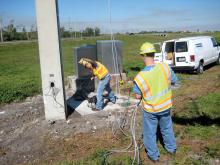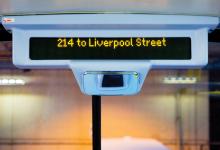
A recent webcast by the US Roadway Safety Institute, based at the
Chen-Fu Liao, senior systems engineer at the university’s Minnesota Traffic Observatory, highlighted the fact that 40 million Americans aged 40 and over have some kind of sight problem, with numbers of the blind expected to double by 2030. There are, he acknowledged, environmental cues available to support such travellers.
But existing smartphone apps typically fail to give sufficiently detailed information on, for example, the physical nature of a pedestrian crossing and the timing of its signals.
He emphasised the importance of overcoming both informational and the physical issues, and showcased the mobile accessible pedestrian system (MAPS) that the university is developing.
This uses smartphone access to deliver, in audio form, highly specific information to visually impaired pedestrians to help overcome the difficulties they often experience in locating the pedestrian push button on a signal at a crosswalk (see panel). With a single tap on the phone they can check the orientation and geometry of the intersection. A double tap then confirms their intention to cross and sends an appropriate message to the signal controller.
Following a trial which exposed the impact of urban canyons on the reliability of the GPS-based location of crosswalks, a further stage used Bluetooth low energy (BLE) modules to feed more specific guidance into smartphones. The modules have a self-monitoring role and will send out alerts of any failure to function, as well as ensuring that the information being supplied to visually impaired pedestrians is up-to-date.
The standard, commercially available BLE tags are designed to be detected or discovered as location markers, and not to communicate with each other. The project has therefore gone on to develop an innovative Bluetooth smart system, ‘BLE-smart’.
This integrates an off-the-shelf module that works in passive or active modes with an interface that enables it to sense similar units operating within its communication range. The overall system works with a local digital map of an unfamiliar or hazardous environment, developed with the support of a dedicated positioning and mapping algorithm.
Each BLE-smart unit is then aware of, and can check on, its neighbours to ensure the correctness of the local map and of the positioning information being delivered in what may be a GPS-denied environment. In turn, a geospatial database containing BLE-smart locations and messages integrates with a smartphone app. The aim is to ensure that users always receive the correct audio information on traffic signal timing and the intersection geometry, at the correct location.
Across in Europe, Jean-Michel Henchoz, of global automotive technology supplier Denso, has warned a European audience that VRUs will be unaware of whether or not an oncoming vehicle is automated.
Speaking at a webinar organised by
Better buttons
Current US accessible pedestrian signal (APS) systems, requires users to search for a special button to trigger audio or vibrotactile guidance. This often diverts users from their natural path of travel, which they typically use as an alignment cue for starting to cross.
The relatively high installation and maintenance costs of these systems deter many public agencies and the audio guidance may be inaudible at peak periods (due to traffic noise), and disturbing to other pedestrians at quiet times. The university believes that there is room for substantial improvements in both design and accessibility.









